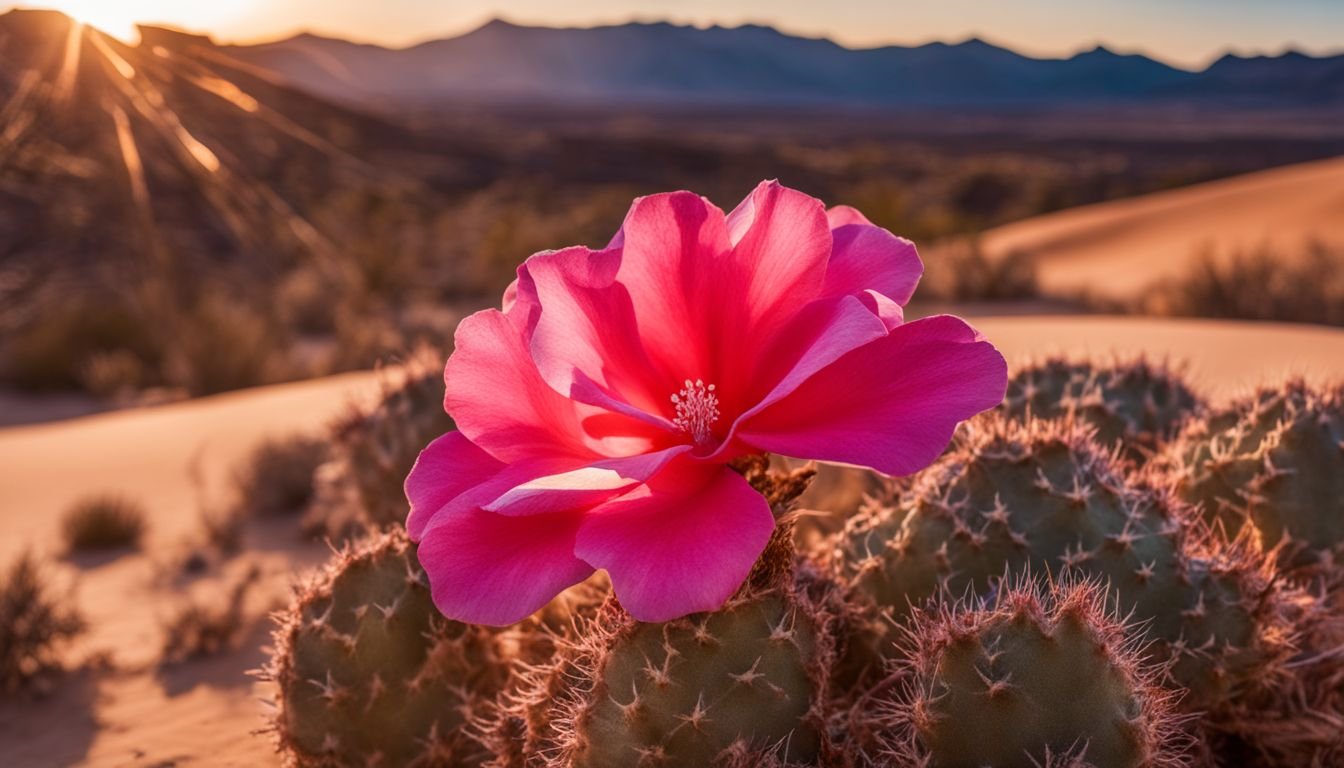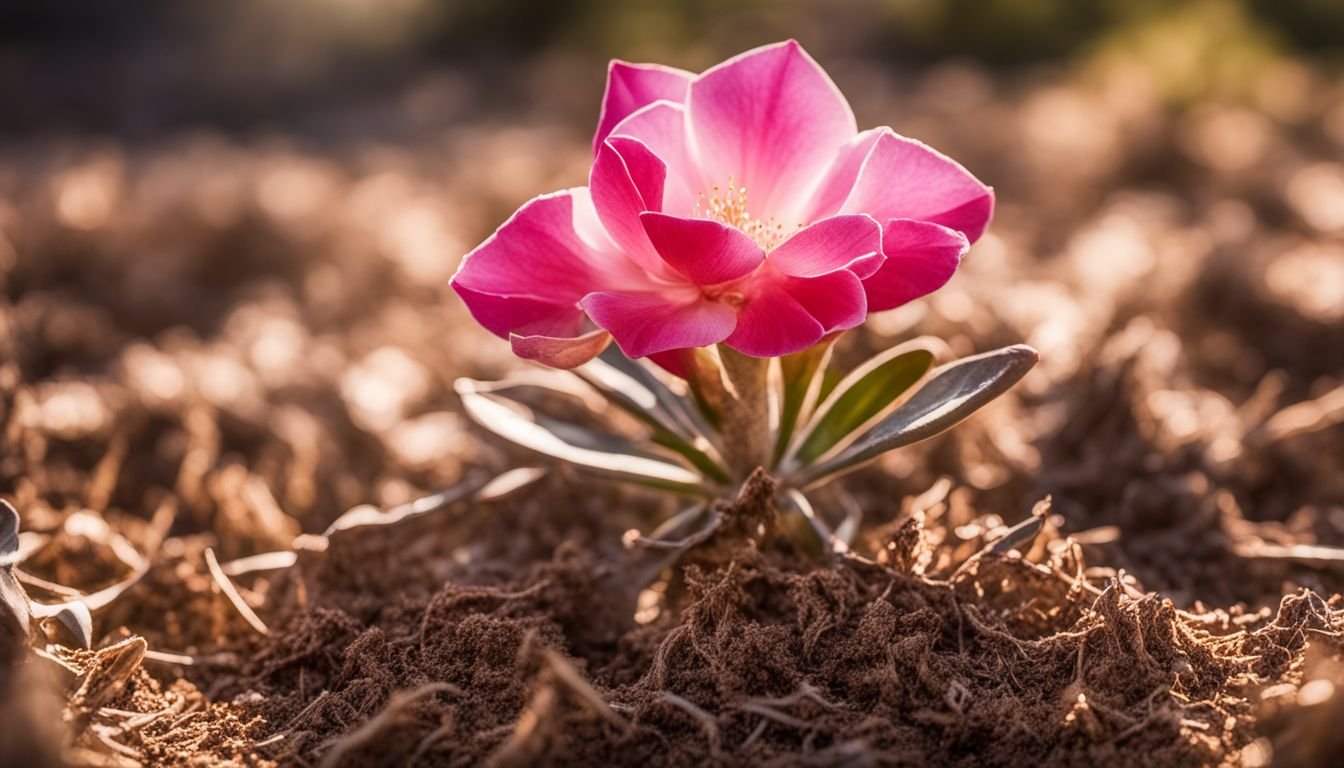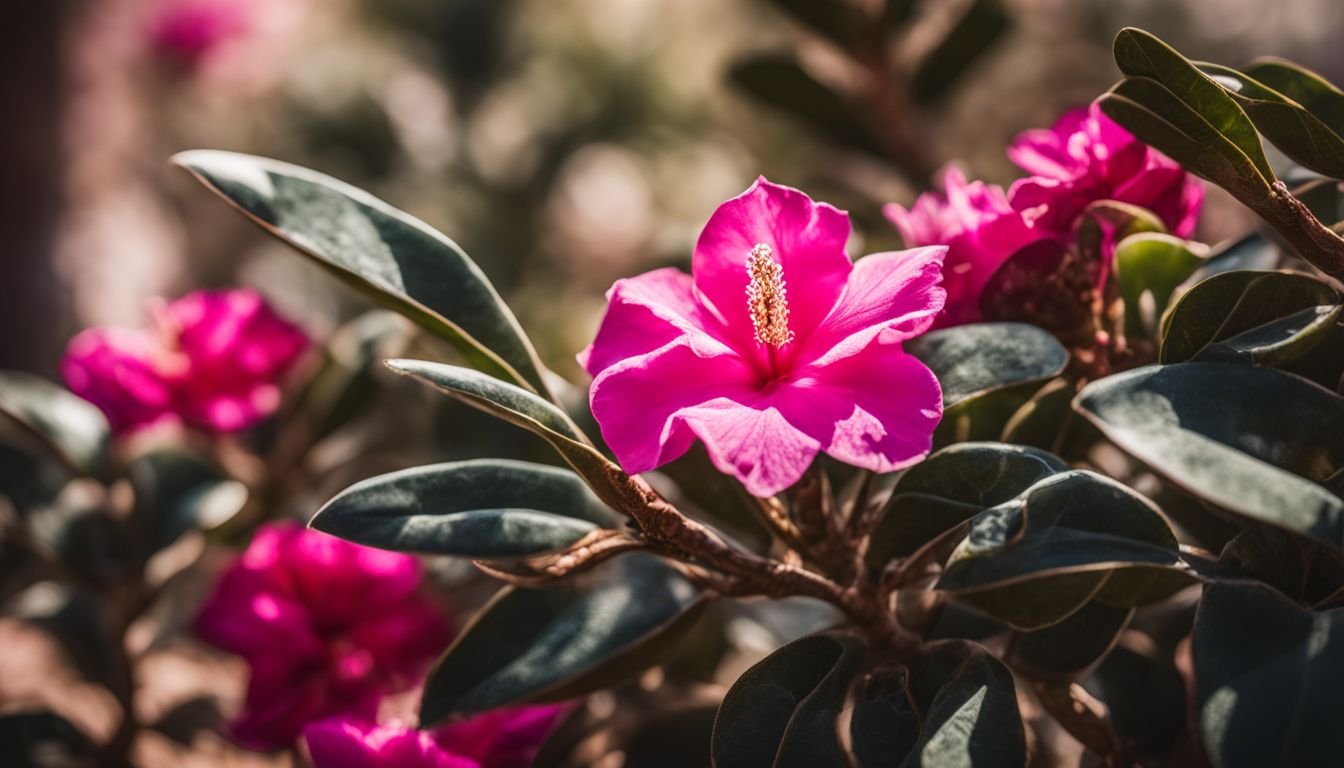Growing Desert Rose plants down under can be a fair dinkum challenge. Many Aussie gardeners often scratch their heads, wondering why their plant isn’t blooming or why its leaves are turning yellow and having a bit of a fall out.
If these issues sound familiar, you’re certainly not on your own. We’ve had our fair share of head-scratching moments, trying to suss out exactly what our Desert Rose needed to really flourish.
After heaps of research and a bit of trial and error, we’ve managed to crack the code on how to give this stunning plant the care it deserves.
In our blog post today, we’re going to spill the beans on everything from snagging the perfect light conditions to mixing up the ideal soil for your Desert Rose (Adenium obesum). Whether you’re planning to grow it in your backyard or keep it as an impressive potted feature, we’ve got you covered.
Plus, we’ll guide you through propagation tips and how to nip any pesky problems in the bud. So grab your gardening gloves – by following our advice, your Desert Rose will soon be thriving, making it a true blue beauty in your garden collection.
Ready for a beaut transformation in your gardening journey?
Key Takeaways
- Desert Rose plants need full sun, at least six hours a day, and well – draining soil to grow strong. Make sure they’re placed in bright spots whether you’re growing them indoors or outside.
- Water your Desert Roses correctly by letting the soil dry out before watering again during growth seasons and cutting back in cooler months. This prevents root rot and keeps the plant healthy.
- Using the right type of soil is crucial for thriving Desert Roses. Mix succulent earth blend with coarse sand and perlite or pumice for indoor plants to ensure good drainage.
- Keep an eye on temperatures as these beauties enjoy warmth between 18°C to 32°C (65°F to 90°F) but can’t handle cold weather. Also, maintain low humidity around them for their best health.
- Watch out for common problems like yellowing leaves, which might be caused by too much water or not enough light; spotting on leaves from pests like spider mites; and non-blooming issues that could arise from overwatering or pest attacks. Regular checks and adjustments will help keep your Desert Rose happy and blooming beautifully.
Key Aspects of Desert Rose Plants
 Desert Rose plants thrive in full sunlight and need well-draining soil to grow. They enjoy a good drink but don’t like wet feet, so let the soil dry out before watering again.
Desert Rose plants thrive in full sunlight and need well-draining soil to grow. They enjoy a good drink but don’t like wet feet, so let the soil dry out before watering again.
Light Requirements
We all know Desert Rose plants love the sun. They thrive under full sun, needing at least six hours of sunlight daily to bloom well. Make sure you pick a sunny spot in your garden with soil that drains water easily.
This will help your Desert Roses to grow strong and show off their beautiful trumpet-shaped flowers.
If you’re growing them indoors, choose a bright spot for the pot. A window that lets in plenty of light works best. The goal is to mimic the natural habitat of these plants as much as possible, even while they’re inside.
Keep an eye on them and turn the pot regularly so each side gets enough light.
Our job is simple: ensure our Desert Rose gets loads of sunshine whether planted in our gardens or sitting in pots indoors. This way, we encourage them to produce those stunning blooms we all admire.
Optimal Soil Conditions
Achieving the right soil conditions is key for thriving Desert Rose plants. These beauties flourish in well-draining sandy earth with a neutral to acidic pH level. For those of us bringing these ornamental shrubs indoors, mixing succulent earth blend with coarse sand and perlite or pumice guarantees good drainage.
This mix prevents the dreaded root rot by ensuring excess water can escape easily.
We must use a potting concoction that supports our desert roses effectively if we want to see them bloom year after year. Propagating new plants? A well-aerated container mixture is ideal for encouraging strong roots from your seeds or seedlings.
Consistently using the correct soil not only boosts plant health but wards off common pests like spider mites, keeping our foliage looking lush and vibrant.
“The perfect soil does more than grow a plant; it breathes life into its very roots.”
Watering Schedule
We keep our Desert Rose plants happy with a smart watering plan. During the growth season, we water just enough to keep the soil moist but not soggy. This ensures roots stay healthy and strong.
As the seasons change to autumn and winter, we cut back on watering. This matches the plant’s natural cycle of slowing down.
Adding liquid food once a month during spring and summer gives our desert beauties an extra boost without overdoing it. We skip this step in cooler months when they’re resting up for their next show of stunning trumpet-shaped flowers.
Now, let’s take a look at how we can keep them cosy with the right temperature and humidity levels.
Suitable Temperature and Humidity
After making sure our desert rose plants get just the right amount of water, we need to focus on keeping them warm and comfortable, much like they would be in their natural habitat.
These beauties thrive in temperatures from 18°C to 32°C (65°F to 90°F), which fits perfectly with Australia’s warmer regions. It’s crucial not to let them get too chilly, especially when frost hits since they can’t handle the cold.
Maintaining low humidity around these plants is also key for their well-being because they’re used to dry conditions. Unlike tropical natives that relish moisture in the air, desert roses prefer it on the arid side.
This means positioning them where airflow is good and avoiding cramped spaces where damp air might gather. By ensuring these conditions, we help prevent issues like powdery mildew or root problems from arising due to excess moisture.
Steps to Grow Desert Rose in a Garden

Growing Desert Rose plants in our gardens here in Australia can bring a touch of exotic beauty to our outdoor spaces. With their striking trumpet-shaped blooms and unique form, they make a captivating addition to any garden setting. Here’s how we do it:
- Choose the right spot: Look for a sunny area that gets plenty of light throughout the day. Desert Roses thrive in hot, dry climates, making them perfect for Australian gardens. The soil should be well-drained; adding sand can help achieve this if your garden soil is too compact or clay-heavy.
- Prepare the soil: Enrich the garden bed with a mix of potting soil and fertiliser before planting. This step ensures that the soil has enough nutrients for your Desert Rose to grow strong and healthy.
- Planting: When it’s time to plant, make sure the root ball is placed at the same depth as it was in its previous container. Be gentle when removing your Desert Rose from its pot and avoid damaging its roots.
- Water wisely: Water your Desert Rose deeply right after planting it. Then, adjust your watering schedule according to the weather and season – more frequent watering in hot, dry periods and less during cooler months. Overwinter, reduce watering significantly to prevent root rot.
- Mulching helps: Covering the soil around your Desert Rose with organic mulch will keep roots cool and retain moisture longer between waterings.
- Pruning for shape: As your Desert Rose grows, prune it regularly to encourage a bushy shape and more flowers. Always use clean tools to prevent spreading diseases between plants.
- Watch out for pests: Keep an eye on plant leaves for signs of pests or diseases like spotting on leaves or yellowing leaves or leaf drop which may indicate too much water or poor drainage.
- Encourage blooming: To promote those beautiful trumpet-shaped blooms, use a high-phosphorus fertiliser every few weeks during the growing season.
Following these steps will help us successfully grow desert rose plants right here in our Australian gardens, adding that special touch of drought-tolerant beauty that thrives in our unique climate.
Propagating a Desert Rose
Moving from planting Desert Rose in your garden, we now focus on how to multiply these stunning plants through propagation. Propagating Desert Rose allows you to create more plants either from seeds or branch sections.
Here’s a straightforward guide to propagate your Desert Rose:
- Choose the right time: Aim for the warmer months to start propagation, as these conditions help seeds sprout and cuttings root faster.
- Prepare for seed planting: If you’re going with seeds, spread them evenly over a pot filled with well-draining potting mix. Lightly cover them with soil and keep the pot in a warm, bright spot.
- Water carefully: Seeds need moist soil to germinate well. Spray water gently to keep the soil damp but not soggy.
- For stem cuttings, use clean tools: Sterilise your pruners before cutting a healthy branch from the mother plant to avoid disease transfer.
- Apply rooting hormone: Dip the cut end of the branch into rooting hormone powder. This step encourages quicker root development.
- Plant in suitable soil: Insert the treated cutting into a pot filled with a mix that drains well. A mixture often recommended includes one part perlite or sand and one part peat or coco coir.
- Keep it warm and lit: Place your pot in an area that receives plenty of light but not direct, harsh sunlight. Warmth is crucial for encouraging roots to form.
- Maintain moisture lightly: Water just enough to keep the soil lightly moist around new cuttings without making it waterlogged.
By following these steps, you can successfully propagate Desert Rose plants and enjoy even more of their beauty around your home or garden.
Common Issues with Desert Rose Plants
Caring for Desert Rose plants brings joy, but sometimes they face challenges. Leaves turning yellow or falling off can disappoint us. Spots on leaves might make us worry too. And if our plants don’t bloom, we start to wonder what went wrong.
We’ll tackle these problems together and find solutions that work.
Yellowing Leaves or Leaf Drop
We often see our desert rose plants struggling with yellowing leaves or even losing them. This problem usually comes from too much water or not enough light. It’s essential to check the plant’s roots for rot, a common issue that leads to these symptoms.
We also look out for powdery mildew and spider mites, which can attack the leaves, making them turn yellow and drop off.
Ensuring proper sunlight and managing how much we water our desert roses play a significant role in keeping their leaves green and healthy. These plants are tough against pests and diseases, perfect for Australian gardens situated in USDA zones 11 and 12.
By paying attention to these details, we help our desert roses thrive without the stress of yellowing leaves or leaf drop.
“A happy plant is all about balance – enough sunlight, right amount of water.”
Spotting on Leaves
After discussing the common problem of yellowing leaves or leaf drop, we move onto another issue our desert rose plants might face – spotting on leaves. This trouble often points to pests like spider mites or fungal infections such as powdery mildew.
Spider mites are tiny critters that suck sap from the leaves, leading to speckled appearances. On the other hand, powdery mildew coats the leaf surface with a white, powdery substance.
Addressing these spots early makes a big difference in keeping our plant healthy. Overwatering is a usual culprit for this problem too; it creates an environment where fungi thrive.
Cutting back on water and ensuring good air circulation around our plants can prevent these issues. For fungal infections, applying organic fungicides and wiping off any affected areas helps control its spread.
If we spot spider mites attacking our desert rose, spraying them with insecticidal soap or neem oil works well in sending them packing.
Regular checks of your desert rose for any signs of distress go a long way in maintaining its beauty and health. Using quality resources like premium potting mix and organic food empowers us to give the best care possible to these exotic beauties.
Joining communities like Yates Garden Community offers more insights into tackling problems including spotting on leaves effectively.
Non-Blooming Issues
Moving from leaf problems, let’s focus on why Desert Rose plants might not be flowering. A big reason for non-blooming is too much water. We all know how tempting it can be to give our plants plenty of water, especially in the heat.
But Desert Rose plants prefer it dry and overwatering them can stop flowers from showing up.
Another enemy of blooming is root rot and a type of fungus called powdery mildew. These issues sneak up because of wet conditions around the plant’s roots or leaves. Keeping things dry helps prevent these problems and encourages your Desert Rose to bloom beautifully.
Lastly, tiny pests known as spider mites love to attack Desert Roses, draining their strength and stopping blooms. Regular checks and cleaning off any pests you find will keep your plant healthy and ready to flower.
Keeping an eye out for these issues means you’ll have a better chance at seeing those stunning blooms year after year.
Conclusion
Caring for Desert Rose plants in Australia brings joy and a touch of the desert’s beauty into your garden or home. With right light, soil, water, and temperature conditions, these stunning plants will flourish.
Using tools like Yates Dynamic Lifter and Thrive Roses & Flowers Plant Food ensures your Desert Roses get the nutrients they need. Remember to protect them from cold by bringing them indoors during frosty weather.
As you follow these steps, watch your Desert Rose thrive and bloom with vibrant colors that enhance any space.
FAQs
1. What is a desert rose plant?
A desert rose plant, also known as sand rose, selenite rose or gypsum rose, is a type of succulent that grows crystals in its roots. These plants are part of the desert flora and thrive in arid conditions.
2. Can I grow desert roses in Australia?
Yes, you can grow desert roses in Australia, especially in temperate climates. They do well in areas like Image Flat, QLD, 4560 because they’re suited for xeriscaping gardens.
3. Do I need special soil to plant a desert rose?
Desert roses require sandy soil to grow properly since they are used to dry environments. Make sure the soil allows for good drainage to prevent root rot.
4. How often should I water my desert rose plant?
Water your desert rose sparingly. These plants store water in their leaves and prefer dry conditions over being too wet. Overwatering can harm them more than underwatering.
5. Are there any quarantine charges for importing desert roses into Australia?
If you plan on importing a desert rose or its seeds into Australia, be prepared for quarantine charges. These regulations help protect local ecosystems from invasive species and diseases.
